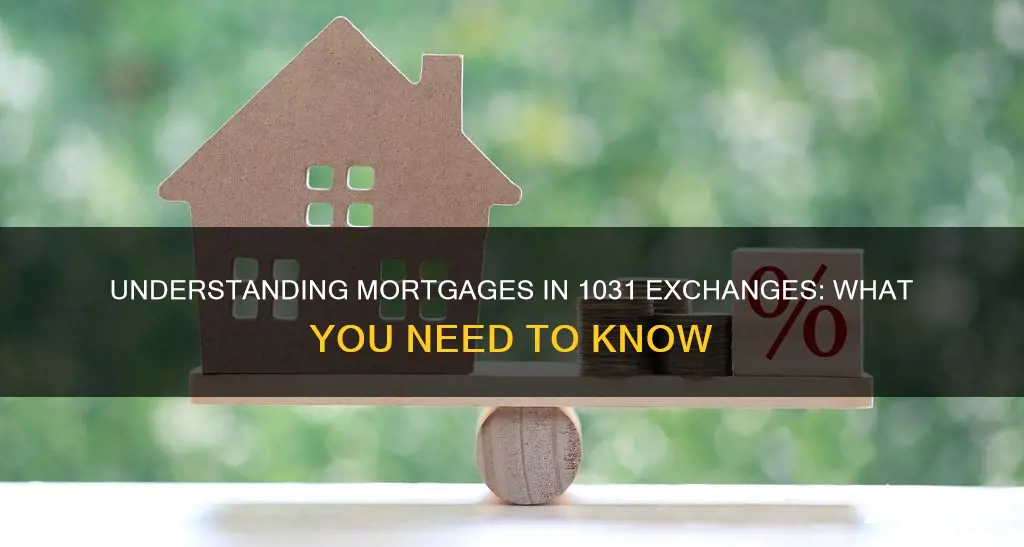
A 1031 exchange is a real estate investing tool that allows investors to swap one property for another while deferring capital gains tax. The term is derived from Section 1031 of the Internal Revenue Code (IRC). This exchange is popular among investors who want to upgrade properties without paying taxes on their profits. To fully benefit from a 1031 exchange, investors must carefully handle the proceeds from the sale, as any leftover cash or mortgage differences can trigger tax liabilities. This is referred to as boot, and it includes scenarios where the new property has a lower mortgage amount than the relinquished property. To avoid these tax implications, investors can reinvest the entire proceeds from the sale, including any outstanding mortgage balance, into the new property.
| Characteristics | Values |
|---|---|
| Definition | A 1031 exchange is a swap of one real estate investment property for another that allows capital gains taxes to be deferred. |
| Source | Section 1031 of the US Internal Revenue Code (IRC) |
| Requirements | The properties must be "like-kind", meaning they are similar in nature and assessed value, though they may differ in quality or grade. The replacement property must be of equal or higher value, and the exchange must adhere to strict time restrictions. |
| Time restrictions | The replacement property must be identified within 45 days, and the exchange must be completed within 180 days. |
| Tax implications | If there is any cash left over after the exchange (known as "boot"), it will be taxable as a capital gain. If the replacement property has a lower mortgage amount, the difference is also considered "boot" and is subject to taxes. |
| Benefits | Allows real estate investors to upgrade properties without paying taxes on proceeds, reinvesting profits from one investment property to the next, and deferring taxes until the property is eventually sold for cash. |
| Considerations | Must consider mortgage loans or other debt on both properties. Proceeds from the sale of the relinquished property must be transferred to a qualified intermediary, who holds the funds until they can be transferred to the seller of the replacement property. |
What You'll Learn
- The presence of a mortgage is permissible on either side of the exchange
- The mortgage amount on the replacement property may be taxed
- The mortgage balance can be reinvested into the new property
- The mortgage on the replacement property must be at least equal to the relinquished property
- The mortgage loan on the relinquished property must be considered

The presence of a mortgage is permissible on either side of the exchange
A 1031 exchange, named after Section 1031 of the Internal Revenue Code, allows investors to swap one piece of real estate investment property for another of similar type, deferring capital gains taxes in the process. The presence of a mortgage is permissible on either side of the exchange, but there are important considerations to keep in mind to avoid creating a taxable event, also known as "boot".
Firstly, it is essential to understand the concept of "like-kind" properties. A 1031 exchange requires that the replacement property be of equal or greater value than the relinquished property, including the value of debt (mortgage) and equity. This means that if you sell a property with a mortgage and use the proceeds to pay off that mortgage, you must take out another mortgage on the replacement property of equal or greater value. Failure to do so will result in a taxable event on the proceeds of the relinquished property.
Secondly, investors should be cautious when contributing additional cash, taking out a larger mortgage, or engaging in a partial 1031 exchange. While it is permissible to take out a larger mortgage on the replacement property, over-financing can create taxable boot if not carefully managed. Any excess borrowing used to acquire the replacement property that is not reinvested into like-kind property will be taxed as cash boot.
Thirdly, time constraints are a critical factor in a 1031 exchange. The replacement property must be identified within 45 days, and the exchange must be completed within 180 days. Failing to meet these deadlines may result in tax liabilities.
Finally, it is important to seek professional advice. A 1031 exchange can be a complex process, especially when a mortgage is involved. Working with an experienced, qualified intermediary, realtor, or tax advisor can help ensure the exchange goes smoothly and that all tax requirements are met.
Lower Fees, Bigger Benefits: Refinancing Your Mortgage
You may want to see also

The mortgage amount on the replacement property may be taxed
A 1031 exchange, named after Section 1031 of the Internal Revenue Code, allows real estate investors to defer capital gains taxes by swapping one real estate investment property for another. This is often referred to as a like-kind exchange.
If the property you are giving up has a mortgage, you will have to pay it off when you sell. However, to receive the full tax deferral of a 1031 exchange, you'll need to take out a new mortgage of equal or greater value when purchasing your replacement property. This is because the proceeds from a 1031 exchange must be handled carefully. If there is any cash left over after the exchange (known as "boot"), it will be taxable as a capital gain. Similarly, if there is a discrepancy in debt—for example, if your old property had a larger mortgage than the new property—the difference in liabilities is treated as boot and taxed accordingly.
For instance, if you sell a property with a $1 million mortgage and buy a new one with a $900,000 mortgage, the $100,000 difference would be taxed as income. One of the main ways that people get into trouble with these transactions is by failing to consider loans. You must consider mortgage loans or other debt on the property you are giving up and any debt on the replacement property. If you don’t receive cash back but your liability goes down, then that will also be treated as income, just like cash.
To fully defer all taxes in a 1031 exchange, it is necessary to carry all equity from the relinquished property forward into a new replacement property. If some or all of the proceeds from the relinquished property sale are used merely to pay down an existing mortgage, the exchanger would have tax exposure on the funds received. Even if the exchanger acquires a new replacement property that meets the necessary value and debt requirements, the funds pulled out of the exchange to pay off the unassociated debt would have tax exposure.
Gifts, Mortgages, and Parental Money: Impact and Insights
You may want to see also

The mortgage balance can be reinvested into the new property
A 1031 exchange, named after Section 1031 of the Internal Revenue Code, allows investors to defer capital gains taxes by reinvesting the proceeds from the sale of a property into a new property of similar type. The term "1031 exchange" is often used by real estate agents, investors, and title companies.
A 1031 exchange can be a complicated process when a mortgage is involved. If the property you are relinquishing has a mortgage, you will have to pay it off when you sell. However, to receive the full tax deferral, you must take out a new mortgage of equal or greater value when purchasing your replacement property. This is known as a like-kind exchange. The mortgage on the relinquished property can be paid off with the exchange proceeds, but it must be replaced with another mortgage on the replacement property to avoid a taxable event.
The mortgage balance from the sale of the relinquished property can be reinvested into the new property. To maximize tax deferral benefits, the debt level on the new property must be at least equal to or higher than that on the relinquished property. This is because the replacement property must be of equal or greater value than the relinquished property to achieve full deferral of capital gains taxes.
For example, let's assume you currently own a $500,000 property with a $200,000 mortgage, and you plan to replace it with an $800,000 property. In this case, you would have sales proceeds of $300,000 after paying off your $200,000 mortgage. You could then combine the $300,000 of sales proceeds with a new $500,000 mortgage to purchase the new property. This would qualify as a full 1031 exchange since both the value of the replacement property and the new debt would exceed the value and debt of the relinquished property.
It is important to note that a 1031 exchange does not have to be an "all-or-nothing" transaction. It is possible to purchase a replacement property with a lower mortgage than the relinquished property. However, doing so would create a taxable event, and the proceeds realized would be treated as income.
Understanding Mortgage Escrow: Accounts, Payments, and Zero Balance
You may want to see also

The mortgage on the replacement property must be at least equal to the relinquished property
A 1031 exchange, named after Section 1031 of the Internal Revenue Code, allows real estate investors to swap one investment property for another without immediately paying capital gains taxes. This is also known as a like-kind exchange or a Starker exchange. The term "like-kind" refers to the nature of the investment rather than the form, meaning any type of investment property can be exchanged for another.
To fully defer all taxes in a 1031 exchange, the replacement property must be of equal or greater value than the relinquished property, and all equity from the relinquished property must be carried forward into the new property. This means that the mortgage on the replacement property must be at least equal to the mortgage on the relinquished property. If the replacement property has a smaller mortgage, the difference in liabilities is treated as "boot" and taxed as income. For example, if an investor sells a property with a $1 million mortgage and buys a new one with a $900,000 mortgage, the $100,000 difference would be taxed as income.
To avoid this, investors can reinvest the entire amount from the sale of the relinquished property, including the net proceeds and any outstanding mortgage balance, into the new property. This ensures that the debt level on the new property is at least equal to or higher than that on the relinquished property, maximizing tax deferral benefits.
It is important to note that there are strict time limits for a 1031 exchange. The replacement property must be identified within 45 days, and the exchange must be completed within 180 days. Additionally, the relinquished property must be held for productive use in a trade, business, or investment, and the replacement property must be used for similar purposes.
Mortgage Rates: Impacting Your Monthly Payment Costs
You may want to see also

The mortgage loan on the relinquished property must be considered
A 1031 exchange, named after Section 1031 of the Internal Revenue Code, allows real estate investors to swap one real estate investment property for another of a similar type, deferring capital gains taxes in the process. The term is often used by real estate agents, title companies, and investors.
When it comes to the mortgage loan on the relinquished property, there are a few key considerations to keep in mind. Firstly, it is important to understand that the mortgage loan on the relinquished property can impact the tax implications of the 1031 exchange. If there is a discrepancy in debt between the old and new properties, the difference in liabilities is treated as "boot" and taxed accordingly. For instance, if you sell a property with a $1 million mortgage and buy a new one with a $900,000 mortgage, the $100,000 difference would be taxed as income. Therefore, it is crucial to carefully handle the proceeds from the 1031 exchange to avoid unexpected tax liabilities.
Another important consideration is the timing of the exchange. In a simultaneous 1031 exchange, the property you sell and the one you buy close at the same time, simplifying the process by avoiding interim steps. However, this type of exchange can be challenging to coordinate. On the other hand, a delayed exchange, the most common type of 1031 exchange, allows investors to purchase a replacement property within 180 days of selling the relinquished property. In this case, the sale proceeds are typically held by a qualified intermediary until the replacement property is purchased. It is worth noting that if the relinquished property is not sold within the 180-day window, the sale will be taxed.
Additionally, when considering the mortgage loan on the relinquished property, it is crucial to ensure that the replacement property meets the requirements of a like-kind exchange. The replacement property must be similar in nature and function to the relinquished property. For example, a rental property cannot be exchanged for a vacation home. It is also important to note that primary residences, second homes, and vacation homes do not qualify for a 1031 exchange.
Furthermore, to fully defer all taxes in a 1031 exchange, it is generally recommended to carry all equity from the relinquished property forward into the new replacement property. If the proceeds from the sale of the relinquished property are used solely to pay down an existing mortgage, the Exchangor may face tax exposure on the funds received. One possible solution to avoid this issue is to complete the exchange using all the equity from the disposition of the relinquished property and then, after a reasonable period, perform a cash-out refinance to pay off the desired proceeds on the other property.
Mortgage Debt Proceeds: Co-Paying Strategies and Options
You may want to see also
Frequently asked questions
A 1031 exchange, named after Section 1031 of the Internal Revenue Code, allows real estate investors to swap an investment property for another of similar type, deferring capital gains taxes.
The presence of a mortgage is permissible on either side of the exchange. If the replacement property has a lower mortgage amount than the relinquished property, the difference is treated as "boot" and is taxable.
"Boot" refers to any leftover cash received in a 1031 exchange, which may trigger capital gains tax.







